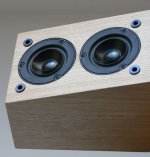Hello all,
I am toying with the idea to build atmos speakers, in equal parts because my new receiver can do it, I have some unused CHR-70 from a never realized project, and I like to try new stuff.
What I want to build is the upfiring variant, not the ceiling mounted. Will be hard enough as it is to justify yet another set of speakers in the living room.
Now, as they will have to do no low frequencies (probably cut off at 180Hz or so) I am planning on doing a small closed box. But my main question is this: the principle of the upfiring atmos speakers is that they are angled in a way so the sound is reflected off the ceiling. As little as possible direct sound should reach the listening position. What I have seen in the different commercial offerings varies from just regularly mounting the chassis like this

to really sink them in the enclosure, like this:

What would be your ideas to achieve a nice directed sound to the ceiling?
I am toying with the idea to build atmos speakers, in equal parts because my new receiver can do it, I have some unused CHR-70 from a never realized project, and I like to try new stuff.
What I want to build is the upfiring variant, not the ceiling mounted. Will be hard enough as it is to justify yet another set of speakers in the living room.
Now, as they will have to do no low frequencies (probably cut off at 180Hz or so) I am planning on doing a small closed box. But my main question is this: the principle of the upfiring atmos speakers is that they are angled in a way so the sound is reflected off the ceiling. As little as possible direct sound should reach the listening position. What I have seen in the different commercial offerings varies from just regularly mounting the chassis like this

to really sink them in the enclosure, like this:

What would be your ideas to achieve a nice directed sound to the ceiling?
Planet10 microTower, angled top variation, use the halfTower dimensions if you only have 2 drivers.
http://frugal-phile.com/boxlib/P10free/microTower-maps-020615.pdf
http://frugal-phile.com/boxlib/P10free/microTower-maps-020615.pdf
Great way to utilize a spare set of drivers, and while I’ve never heard an Atmos system - or even contemplated one, I can’t think you’d have anything to lose in trying, except a few hours in the shop and a few square feet of material. While the CHN70s are known for a different tonal signature that most of Mark’s designs, I’d suspect that as “surround effects” channels, those ceiling mounted or reflected speakers needn’t be as free from colorations as the main front row 3.
If it’s not something that is specified by THX Labs, or readily found in manufacturers’ documentation, you might need to experiment a bit with angle of tilt of the enclosures. Of course, I’d imagine that any Atmos enables processor/receiver would include a mic and auto-setup for level calibration, as well as broadband EQ for each channel, should it be required.
edit - re Craig’s suggestion for the Castle Microtowers, keep in mind that (what I’ll call) the ceiling splash speakers would need to be isolated from the L&R mains if enclosed in the same cabinets. So the next question becomes - what are / will be the front mains?
If it’s not something that is specified by THX Labs, or readily found in manufacturers’ documentation, you might need to experiment a bit with angle of tilt of the enclosures. Of course, I’d imagine that any Atmos enables processor/receiver would include a mic and auto-setup for level calibration, as well as broadband EQ for each channel, should it be required.
edit - re Craig’s suggestion for the Castle Microtowers, keep in mind that (what I’ll call) the ceiling splash speakers would need to be isolated from the L&R mains if enclosed in the same cabinets. So the next question becomes - what are / will be the front mains?
Last edited:
I couldn’t find a definitive angle requirement for the Atmos speakers but the KEF versions have a 20 degree angle from my measurements of the KEF installation drawings. Flat smooth ceilings (parallel to the floor) are also recommended, not textured or angled, for optimum effect.
I realize that the microTowers are MLTL so that begs another question: are you intending to put these on top of existing speakers or have stand-alones? If on top, then what are the dimensions of the existing speakers as that will determine the size of the Atmos add-ons.
Wow, thanks for all the interest in this topic.
I want to focus on the front pair first, and if that really gives me a benefit over the existing 5.2 I will then build totally new rears that include both surround and atmos speakers in one enclosure (long time project on the horizon). For that the angled microTower might really be a good starting point.
But front first. They will have to go on top of these (self designed TQWT with Alpair10.3):
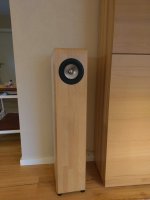
So you see that there is just no way to fit something with the volume you would need for a traditionally designed standalone speaker with the CHR-70. Its going to be more like the two examples I had in my first post. Sacrifice the lower octaves to get small size.
My question also was more of a theoretical nature. What do you do (and I realize this is traditionally exactly what you want to avoid when designing a speaker) to achieve a "tight beam" of sound that is very directed?
As to the angle, I was going to look at the recommended placement of ceiling speakers and then just aim my speakers at that point. Maybe even make it adjustable by putting it on three feet and make the rear one screw in and out. Oh, and the ceiling is 2.5m high, solid concrete.
I want to focus on the front pair first, and if that really gives me a benefit over the existing 5.2 I will then build totally new rears that include both surround and atmos speakers in one enclosure (long time project on the horizon). For that the angled microTower might really be a good starting point.
But front first. They will have to go on top of these (self designed TQWT with Alpair10.3):

So you see that there is just no way to fit something with the volume you would need for a traditionally designed standalone speaker with the CHR-70. Its going to be more like the two examples I had in my first post. Sacrifice the lower octaves to get small size.
My question also was more of a theoretical nature. What do you do (and I realize this is traditionally exactly what you want to avoid when designing a speaker) to achieve a "tight beam" of sound that is very directed?
As to the angle, I was going to look at the recommended placement of ceiling speakers and then just aim my speakers at that point. Maybe even make it adjustable by putting it on three feet and make the rear one screw in and out. Oh, and the ceiling is 2.5m high, solid concrete.
Looked at pics of Kef, Elac and Jamo so just took a punt.
I used 15° as it is a standard setting on all my machining equipment. The other option was 22.5° but seemed too much for my use as they also had to stand upright for presence speakers which is how they are used. I haven't tried them doing Atmos as my current Receiver doesn't support it.
Dolby have a section on Atmos and ceiling speakers angles so maybe if you aimed them at a mid point from the fronts to that location it would be a good starting point.
Dolby Atmos 5.1.2 Speaker Setup
I used 15° as it is a standard setting on all my machining equipment. The other option was 22.5° but seemed too much for my use as they also had to stand upright for presence speakers which is how they are used. I haven't tried them doing Atmos as my current Receiver doesn't support it.
Dolby have a section on Atmos and ceiling speakers angles so maybe if you aimed them at a mid point from the fronts to that location it would be a good starting point.
Dolby Atmos 5.1.2 Speaker Setup
Attachments
Last edited:
The dolby guide seems pretty helpful, thanks.
And those little speakers look gorgeous. Nice work.
And those little speakers look gorgeous. Nice work.
I’m not so sure that sacrificing the bottom couple of octaves for the upfiring Atmos “ceiling splash” enclosures will be all that much of a detriment to the overall effect. My own HT rig is currently only 7.1, and uses Mark Audio drivers for all but the dual woofers on the .1 channel.
A10.3 / A11MS for L&R mains, A10.3 centre, Pluvia7 front height, A5.2 rear surrounds. Even though the Audyssey auto-calibration detects the front row as large, I’ve set the LFE crossover for them to THX suggested 80Hz, the Pluvias to 120Hz and the rears to 150.
If the room was larger than 320 sq ft, and I could afford fullbandwidth systems all around, those would get played with but as it is there’s as much volume and bass as needed, and when I want the full body massage, there’s lots of local cinemas. BTW, Bohemian Rhapsody will be released in IMAX, playing at soon at the Nat Geo theatre in Victoria. My wife has already said “I’d watch it again” - which I was quite surprised to hear.
A10.3 / A11MS for L&R mains, A10.3 centre, Pluvia7 front height, A5.2 rear surrounds. Even though the Audyssey auto-calibration detects the front row as large, I’ve set the LFE crossover for them to THX suggested 80Hz, the Pluvias to 120Hz and the rears to 150.
If the room was larger than 320 sq ft, and I could afford fullbandwidth systems all around, those would get played with but as it is there’s as much volume and bass as needed, and when I want the full body massage, there’s lots of local cinemas. BTW, Bohemian Rhapsody will be released in IMAX, playing at soon at the Nat Geo theatre in Victoria. My wife has already said “I’d watch it again” - which I was quite surprised to hear.
Ok, I basically made the decision for the dimensions of the first trial build in mdf. I am going for the design like the Onkyo's in my first post and make them as big as I dare. That means 2,7 liters  . Closed box, as mentioned. That still gives me a simulated -3dB at 95Hz. No problem at all I would think.
. Closed box, as mentioned. That still gives me a simulated -3dB at 95Hz. No problem at all I would think.
Lets see how long it takes to actually build these. Not that much work, but ... well, let's just say I get lost in the details sometimes.
 . Closed box, as mentioned. That still gives me a simulated -3dB at 95Hz. No problem at all I would think.
. Closed box, as mentioned. That still gives me a simulated -3dB at 95Hz. No problem at all I would think.Lets see how long it takes to actually build these. Not that much work, but ... well, let's just say I get lost in the details sometimes.
If you're going to use the Onkyo "sunken driver" method I wouldn't use cloth grills to cover them. Guests might mistake the grill for a solid horizontal surface and use it as a large drinks coaster. 😱 I'd say either perforated metal or no grill at all. That may depend on WAF/SAF, however, if it's an issue.
If you're going to use the Onkyo "sunken driver" method I wouldn't use cloth grills to cover them. Guests might mistake the grill for a solid horizontal surface and use it as a large drinks coaster. 😱 I'd say either perforated metal or no grill at all. That may depend on WAF/SAF, however, if it's an issue.
This is something that I have been thinking about also. In front of the chassis, on the wall that is shielding the direct sound from the listening position, I want to have some sound absorbing material. Thick felt most likely. At least that will have to be covered and hidden somehow. Because, yes, WAF is most definetly an issue. I already aroused suspicion by staying up very late for internet research and then doing some harmless measuring in the living room. "You are thinking about building new speakers again, aren't you?!" she said. 🙄 Seems my behavioral patterns are rather transparent.
But that is something I will hopefully have thought out for the final build in nice wood. First comes the quick hack in mdf to try this out, and see if this atmos thing has some merit.
At least this first pair won't have an additional footprint since they'll mount on top of existing speakers. Much easier to sell the concept! The floorstanders, however... well, Valentine's Day is coming so maybe you can use that to soften her up to the idea.
It shouldn’t be all that difficult to build a pair of angled boxes with d x w matching the top of the existing MLTLs. I would however avoid the cavity seen in the Onkyos, and plan on some type of metal grille - either waffle or fine mesh type such as many options available from Parts Express or Madisound. All of Mark’s thin metal alloy cones are definitely more susceptible to unrepairable damage than the thicker paper or plastic types used by other manufacturers, and I’d definitely want to give them some protection. The metal grills would be easy enough to cover with speaker fabric if the exposed metal didn’t past the WAF test.
... I would however avoid the cavity seen in the Onkyos, ...
I would be very interested in your reasoning behind that statement. I know that the majority of atmos speakers don't have a cavity like the onkyos. But it just makes so much sense in my mind: if, when seated in the listening position, I can't see the driver then there is also no direct sound reaching me. In theory I am only supposed to hear what is reflected off the ceiling, and that cavity seems to me a straightforward way to reach that.
Test cabinets are done, just waiting for the glue to set. In the picture an intermediate step just missing one side wall, and the chassis for size comparison.
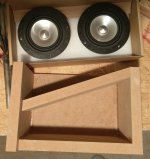
The mdf is unnecesseraly thick, but its just 1 mm thicker than the wood I am planning to build the final ones out of, just for reasons of availability.
I went with the standard 20° angle. For a direct line from speaker to listening position with reflection on the ceiling I calculated something like 35°, because I sit rather far away from the speakers. I am planning on just propping them up in the rear incrementally and see what works best.
Tomorrow I will do the dampening material, both for the inside and in front of the chassis. And then I can already start beeping (aka letting the avr do its calibration measurements). Excited like a school boy. 😀
Time to download some atmos trailers.

The mdf is unnecesseraly thick, but its just 1 mm thicker than the wood I am planning to build the final ones out of, just for reasons of availability.
I went with the standard 20° angle. For a direct line from speaker to listening position with reflection on the ceiling I calculated something like 35°, because I sit rather far away from the speakers. I am planning on just propping them up in the rear incrementally and see what works best.
Tomorrow I will do the dampening material, both for the inside and in front of the chassis. And then I can already start beeping (aka letting the avr do its calibration measurements). Excited like a school boy. 😀
Time to download some atmos trailers.
Cavity resonanceI would be very interested in your reasoning behind that statement.
I hope you chamfered the rear side of the diver through hole before gluing up - I’d definitely consider that mandaiwith any full range driver of this overall (shallow) depth.
If these are just test cabinets, consider BB plywood for the final build - 15mm would be more than sufficient - and I’ll repeat my comment re cavity resonance / reflections from that front panel.
If these are just test cabinets, consider BB plywood for the final build - 15mm would be more than sufficient - and I’ll repeat my comment re cavity resonance / reflections from that front panel.
Last edited:
Done. I never promised they would be pretty. 😀
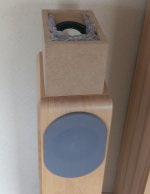
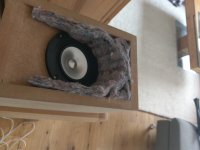
Well, I was planning on dampening the cavity from the start, so never thought this would be an issue. At first I only wanted to cover the front wall of the cavity with felt, but now since you all were so concerned with resonance and reflections I opted for a nice collar parallel to the direction I want the sound to travel. Do you still think that this could be a problem?


Cavity resonance
Well, I was planning on dampening the cavity from the start, so never thought this would be an issue. At first I only wanted to cover the front wall of the cavity with felt, but now since you all were so concerned with resonance and reflections I opted for a nice collar parallel to the direction I want the sound to travel. Do you still think that this could be a problem?
- Status
- Not open for further replies.
- Home
- Loudspeakers
- Full Range
- atmos presence speakers with CHR-70
